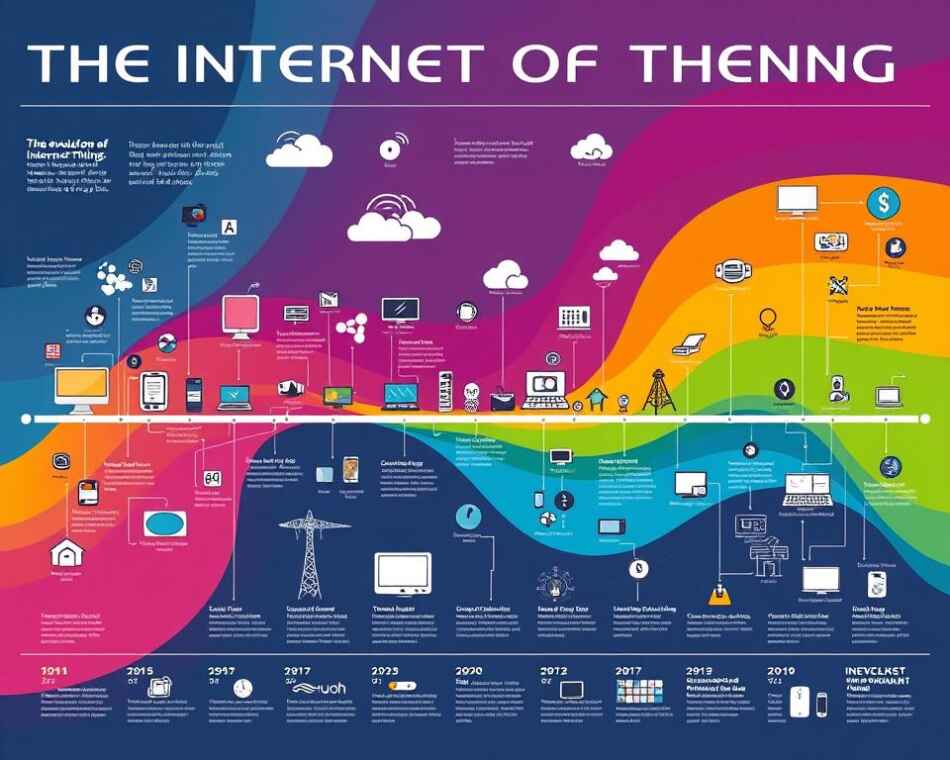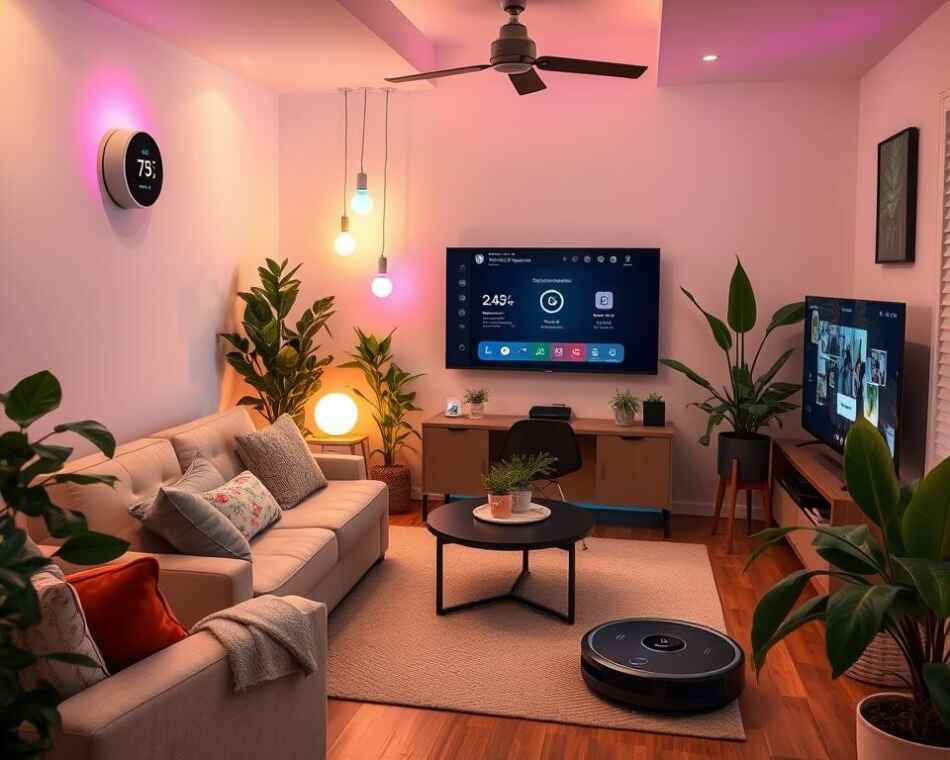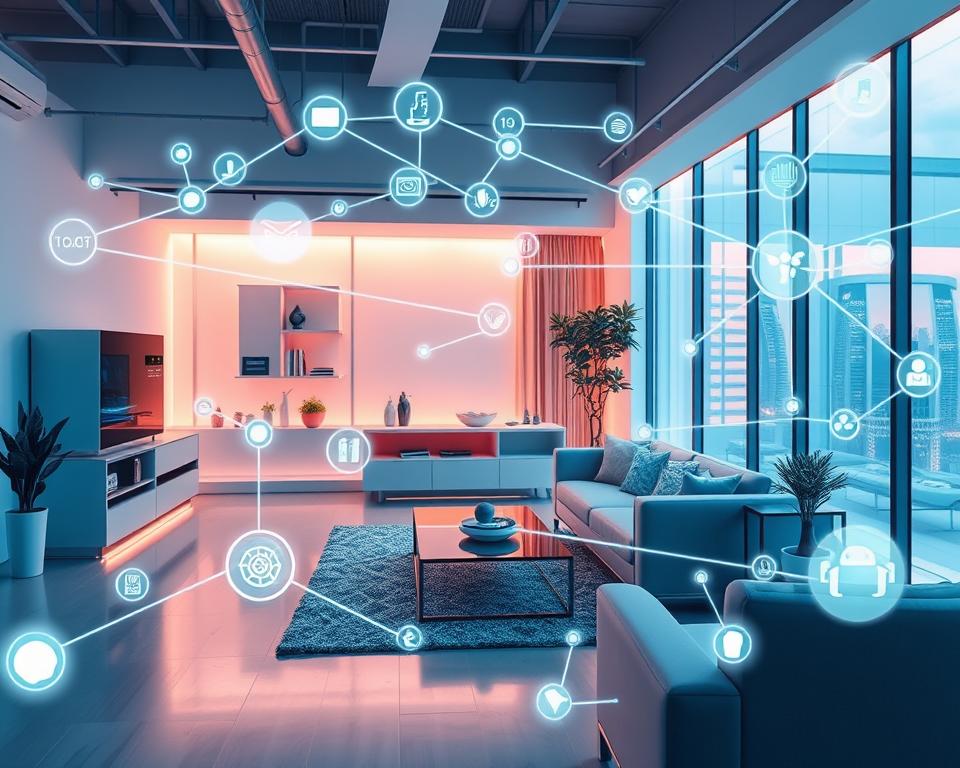I’m excited to explore the Internet of Things (IoT) with you. It has changed our world in amazing ways. Now, we live, work, and interact with technology in new ways.
Did you know there are 35 billion IoT devices worldwide now? By 2021, that number will soar to 46 billion1. This shows how fast IoT is becoming a part of our lives.
Smart Home Tech: The Internet of Things (IoT) brings excitement to smart home tech. It uses sensors, automation, and connected devices. This makes homes more convenient, energy-efficient, and personalized.
With smart home tech, you can control lights, temperature, security, and entertainment from your phone or voice assistant. It simplifies your daily routine and boosts your home’s performance. You can adjust your thermostat and get alerts for security threats.
Smart home tech is key to modern living. It enhances comfort, safety, and quality of life. It offers many benefits that make your home better.
IoT is everywhere, from our phones and wearables to smart home appliances1. It’s not just for fun. In healthcare, IoT wearables track our health, helping doctors catch problems early2. In factories, sensors watch over machines, avoiding expensive breakdowns2.
As we dive into this future tech, we’ll see how IoT is changing our world. We’ll look at its benefits and challenges. Get ready to see how this technology is making our future smarter and more connected.
What is the Internet of Things?
The Internet of Things (IoT) is a network of connected devices. These devices share data and communicate with each other. IoT has changed our lives, from smart homes to industrial uses. Let’s explore its core, evolution, and main parts.
Definition and Core Concepts
IoT means physical objects with sensors, software, and connectivity. These objects range from simple items to complex machines. They collect and share data, leading to automation and better decision-making.
IoT devices help make data-driven choices. They provide a lot of information on customer behavior, market trends, and how things work3.
Evolution of IoT Technology
The idea of IoT started in the 1980s but has grown a lot since then. By 2023, IoT spending is expected to hit $1.1 trillion worldwide. This growth is pushing innovation in many areas, like manufacturing, agriculture, and smart homes.
Key Components of IoT Systems
IoT systems have important parts:
- Physical devices with embedded sensors
- Connectivity technologies (WiFi, Bluetooth, cellular)
- Cloud computing for data storage and processing
- Big data analytics for insights
- Security and privacy technologies3
These parts work together to make strong IoT systems. For example, in retail, IoT sensors and beacons can boost efficiency by up to 30%. This leads to more sales4. As IoT grows, it’s changing industries and opening new doors for innovation and growth.
The History and Development of IoT
I’ve explored the exciting history of IoT, starting from the 19th century. The telegraph in the 1830s and 1840s was the first step. Then, in 1900, the first radio voice transmission happened5. These early steps set the stage for today’s connected devices.
The internet began in 1962 with DARPA and ARPANET in 19695. By the 1980s, it was ready for commercial use. This time saw the start of smart appliances, even if they were simple compared to now. Kevin Ashton coined “Internet of Things” in 1999 for Procter & Gamble, starting the IoT era5.

The early 2000s were key for IoT growth. Walmart and the US Department of Defense used RFID for inventory tracking in 2002-20035. By 2008, more devices were connected than people6. This trend kept going, with 25% of businesses using IoT by 2019, up from 13% in 20146.
Now, billions of devices are connected7. IoT has changed many areas, like smart homes and industries. Healthcare and cars use it for real-time updates5. Looking ahead, we expect 41.6 billion devices by 20256.
How IoT Works: A Simple Explanation
I’m excited to explain IoT in simple terms. The Internet of Things (IoT) connects devices that share data. Let’s look at its main parts and how they work together.
Data Collection through Sensors
IoT sensors are like the eyes and ears of the system. They collect data like temperature, motion, or light levels. These devices can do simple tasks or complex ones like video feeds8.
In smart homes, sensors in thermostats and security systems watch over us9.
Connectivity and Communication Protocols
After collecting data, it needs to be sent somewhere. This is where connectivity protocols play a role. IoT devices use WiFi, Bluetooth, cellular networks, and more to connect to the cloud8.
Each protocol is best for different tasks. For example, smartwatches often use Bluetooth to connect to phones9.
Data Processing and Analytics
The heart of IoT is data analytics. Once data reaches the cloud, it’s analyzed. This can be simple, like checking a temperature, or complex, like using computer vision8.
The insights from this analysis help make decisions and automate IoT systems.
User Interfaces and Applications
Finally, we have the user interface. This is where humans interact with IoT systems. These interfaces can be apps or web browsers that let us check system status and change settings8.
They might send alerts via email or text when needed. For example, a smart home app might let you adjust your thermostat remotely9.
IoT combines these elements to automate processes, save energy, and provide insights9. It’s changing how we interact with the world, from smart homes to industrial applications.
Common Examples of IoT in Everyday Life
I’ve seen IoT devices everywhere in my daily life. Smart home devices are changing how we live. My smart thermostat adjusts the temperature for me, saving energy and keeping me cozy. I can also control my lights from afar, set timers, and even change their colors to match my mood10.
Wearable technology is always with me. My smartwatch tracks my fitness, heart rate, and reminds me to move if I’m sitting too long. It feels like having a health assistant on my wrist.

In the kitchen, IoT makes cooking easier. My fridge has cameras I can see through my phone, helping me check what groceries I need. Some smart ovens can even figure out the best cooking settings for my meals1112.
IoT is also big in farming and cities. Farmers use sensors to watch over their crops and animals, using resources better and growing more. In cities, IoT helps with toll collection, making my drive to work smoother1112.
With over 29 billion IoT devices expected by 2030, it’s clear IoT is here to stay. It will keep changing our lives in exciting ways11.
The Internet of Things Ecosystem
I’m excited to explore the vast world of IoT applications. The Internet of Things ecosystem is growing fast. Experts say the number of IoT devices will jump from 8.74 billion in 2020 to over 25.4 billion by 203013. This growth is happening in many areas, from our homes to entire cities.
Smart Home Devices
Home automation is leading the way in IoT innovation. I’ve seen how smart thermostats, lighting systems, and appliances are changing our daily lives. These devices, controlled by apps or voice commands, make our homes more efficient and comfortable.
Wearable Technology
Wearables like fitness trackers and smartwatches are everywhere. They track our health and activity, giving us insights into our well-being. This helps us make better choices about our lifestyle.
Industrial IoT Applications
In the industrial sector, IoT is changing manufacturing and logistics. These applications make processes better, improve efficiency, and offer chances for sustained value creation14. The potential for business growth through IoT solutions is huge, going beyond just saving money.
Smart Cities and Infrastructure
Smart cities use IoT to improve urban living. I’m amazed by how these technologies monitor air quality, manage traffic, and optimize energy usage. These advancements are making our cities more sustainable and livable.
The IoT ecosystem is vast and complex, but its potential to improve our lives is clear. From smart homes to entire cities, IoT applications are reshaping our world. They offer innovative solutions to old problems14.
Benefits and Challenges of IoT Technology
I’ve seen how the Internet of Things (IoT) is changing our world. The IoT’s benefits are amazing. By 2025, we’ll have 21.5 billion IoT devices, changing industries and daily life15. This growth brings both great opportunities and big challenges.
IoT is making a big difference in manufacturing. Smart factories use IoT for predictive maintenance and quality control. This leads to better efficiency, cost savings, and quality16. Businesses are finding new ways to make money by analyzing IoT data15.
But, there are also big risks. Security and data privacy are major concerns with IoT. The amount of data from IoT devices raises privacy worries15. Companies are using strong encryption and regular security checks to tackle these issues16.
Other challenges include making sure devices work together and dealing with high costs. Solutions like standard protocols and edge computing are helping solve these problems16. As we move forward, it’s important to enjoy the benefits of IoT while keeping security and privacy in mind.
IoT Security and Privacy Concerns
I’ve seen more people worried about IoT security and data protection. The fast growth of connected devices has brought new cybersecurity challenges. With IoT devices now making up 30% of all devices on enterprise networks, the risks are big17.
Potential Vulnerabilities in IoT Devices
IoT devices often have weak spots that hackers can exploit. A shocking 98% of all IoT device communication is unencrypted, leaving data exposed17. Weak authentication and outdated firmware are common issues. In 2020, a cybersecurity expert hacked a Tesla Model X in under 90 seconds using a Bluetooth vulnerability17.
Data Protection Strategies
To tackle these risks, we need strong data protection strategies. Encryption is key for securing data transfer from IoT devices to networks18. Regular software updates and patches are crucial to address vulnerabilities in IoT systems18. Implementing strong authentication mechanisms can significantly improve IoT security.
Best Practices for Secure IoT Implementation
For better IoT security, I recommend:
- Using layered security with firewalls and intrusion detection systems18
- Limiting access privileges to prevent unauthorized data access
- Conducting thorough testing during IoT device development
- Educating users about IoT security best practices
By following these steps, we can make our IoT ecosystems more secure and protect our data from cyber threats.
The Future of IoT: Trends and Predictions
I’m excited about the future of IoT growth and smart devices. The Internet of Things is set to explode, with predictions showing a leap from 9.7 billion devices in 2020 to a staggering 29 billion by 203019. This surge in connectivity will reshape our world, touching every aspect of our lives and industries.
The IoT market is on a fast track, expected to hit $33.74 billion by 202719. Key sectors like electricity, gas, and government have already deployed over 100 million IoT devices. Connected vehicles and asset tracking are racing towards the billion-device mark by 203019. In our homes, we’ll see 350 million new smart devices by 2024, making daily life more convenient and efficient19.
Healthcare is a prime example of IoT’s transformative power. The IoT healthcare market is set to skyrocket to $267 billion next year, promising better patient care and streamlined operations19. IoT security is also evolving rapidly, with consumers and governments alike pushing for stronger protections. This focus on security is crucial as cyberattacks increasingly target IoT-enabled organizations.
Looking ahead, I see IoT playing a pivotal role in sustainability efforts. By 2024, we’ll likely see a surge in IoT solutions for energy efficiency, smart waste management, and precision agriculture19. The retail sector is poised for massive IoT investment, potentially reaching $177.9 billion by 203120. With these advancements, future tech will not only make our lives easier but also contribute to a greener, more sustainable world.
FAQ
What is the Internet of Things (IoT)?
How does IoT work?
What are some common examples of IoT in everyday life?
What are the benefits of IoT technology?
What are the potential security and privacy concerns with IoT?
What does the future of IoT look like?
Source Links
- https://www.disruptive-technologies.com/explore/a-beginners-guide-to-the-internet-of-things-iot-2022 – A Beginner’s Guide to The Internet of Things (IoT) + [PDF] | Disruptive Technologies
- https://medium.com/@rickspair/the-internet-of-things-a-beginners-guide-to-the-connected-world-iot-innovation-technology-0e345a313577 – The Internet of Things: A Beginner’s Guide to the Connected World | #iot #innovation #technology
- https://www.ibm.com/topics/internet-of-things – What is the Internet of Things (IoT)? | IBM
- https://www.techtarget.com/iotagenda/definition/Internet-of-Things-IoT – What is IoT (Internet of Things)? | Definition from TechTarget
- https://www.dataversity.net/brief-history-internet-things/ – A Brief History of the Internet of Things – DATAVERSITY
- https://www.visionofhumanity.org/what-is-the-internet-of-things/ – IoT Technologies Explained: History, Examples, Risks & Future
- https://www.britannica.com/science/Internet-of-Things – Internet of Things | Definition, History, Examples, & Privacy Concerns | Britannica
- https://medium.com/iotforall/iot-explained-how-does-an-iot-system-actually-work-e90e2c435fe7 – IoT Explained — How Does an IoT System Actually Work?
- https://www.coursera.org/articles/internet-of-things – What Is the Internet of Things (IoT)? With Examples
- https://www.deepseadev.com/en/blog/examples-of-iot-in-daily-life/ – 7 Best IoT Devices Examples in Daily Life | DeepSea
- https://www.cbtnuggets.com/blog/technology/networking/seven-examples-of-iot-in-everyday-life – 7 Examples of IoT in Everyday Life
- https://builtin.com/articles/iot-examples – 30 Internet of Things Examples to Know in 2024 | Built In
- https://www.mdpi.com/2624-831X/3/4/22 – A Holistic Overview of the Internet of Things Ecosystem
- https://www.deloitte.com/global/en/Industries/tmt/perspectives/internet-of-things-ecosystem.html – The Internet of Things Ecosystem | Deloitte | Technology, Media & Telecommunications
- https://www.pixelcrayons.com/blog/dedicated-teams/what-are-pros-and-cons-of-internet-of-things/ – What are Pros and Cons of Internet of Things(IoT)?
- https://www.peerbits.com/blog/iot-in-manufacturing-use-cases-and-benefits.html – Use cases, benefits & challenges of IoT in manufacturing
- https://www.zenarmor.com/docs/network-security-tutorials/what-is-iot-security – What is is IoT Security? IoT Security and Privacy Issues – zenarmor.com
- https://deviceauthority.com/security-and-privacy-issues-in-iot-generated-big-data/ – Security and Privacy Issues in IoT Generated Big Data – Device Authority
- https://imaginovation.net/blog/iot-development-trends-predictions/ – Future of IoT Development: Trends for 2024
- https://www.forbes.com/sites/bernardmarr/2023/10/19/2024-iot-and-smart-device-trends-what-you-need-to-know-for-the-future/ – 2024 IoT And Smart Device Trends: What You Need To Know For The Future

